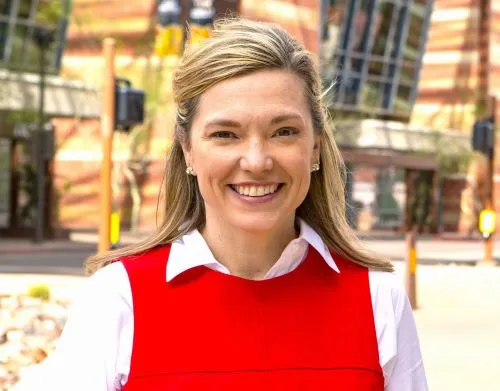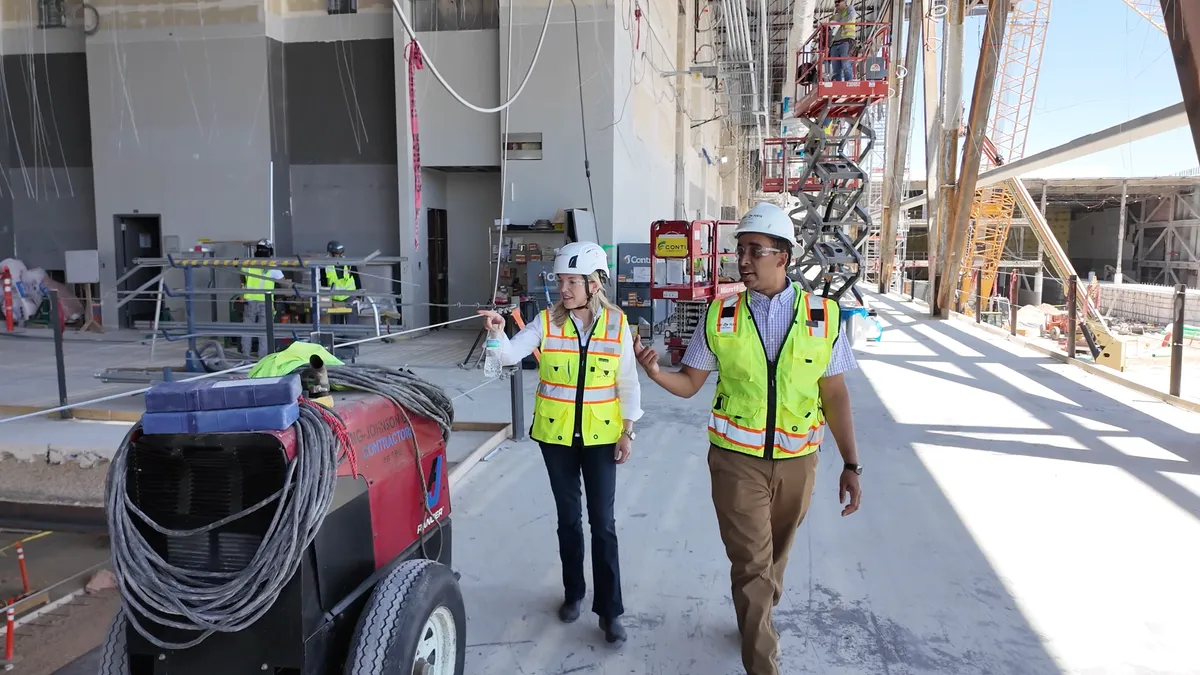This article is one in a series of conversations with women leaders in the construction industry. Click here for past discussions.
Corissa Smith knows convention centers.
As the executive vice president and market lead for AECOM Hunt, she oversees the company’s projects in its convention center sector. Appointed to the role earlier this year, Phoenix-based Smith supports the company’s market strategy nationwide.
Throughout her nearly 30-year career in construction, she has seen changes in both how and where the facilities are built, as well as their design and function. Convention centers now are more vertical, more urban-based and more multi-use, she said.
Her past work has included large-scale convention center expansions in Phoenix; Sacramento, San Jose and San Francisco in California; and San Antonio, Texas. She has also worked on major sports facilities including State Farm Stadium in Phoenix, home of the NFL’s Cardinals, and T-Mobile Park in Seattle where Major League Baseball’s Mariners play. The variety of the work is part of what drew her to construction, she said.
“Each project presents a different experience, a different team, a different learning opportunity. And that’s the amazing thing about construction — you’re constantly evolving, you get to start over every few years on a new project, and it’s always changing,” she said. “It’s so dynamic and so interesting, you could never get bored.”
Here, Smith talks with Construction Dive about her career trajectory, her favorite projects and how convention centers have transformed over the years.
This interview has been edited for brevity and clarity.
CONSTRUCTION DIVE: What led you to choose construction for your career?

CORISSA SMITH: I started with a degree in architecture and realized before I even began working, I wanted to know more about how buildings are actually built and have a real understanding of construction. I joined a construction firm intending to learn how to build buildings so I could be a better architect down the road. And today, all these years later, I’ve never gone back to architecture because I’m still learning.
My first project was what is now T-Mobile Park in Seattle, and as the baseball stadium in my hometown, I couldn’t imagine there was any more amazing project I could be a part of. It was an incredible experience, and those projects kept coming!
What are a few of the projects you’ve most enjoyed working on and why?
Part of what makes this work so rewarding and interesting is how unique each project is, and so it’s hard to choose. But as I think of some of the more pivotal projects of my career, there are two, one is what was originally called Cardinals Stadium in Phoenix — now named State Farm Stadium — and the other is the Phoenix Convention Center.
The Cardinals Stadium was a design-build project, and the first one I led. As part of the design, construction strategy and schedule, we embarked on a plan to do a single roof lift to put the structure in place, 5,400 tons all at the same time.
The project was a big undertaking, and one that I relocated from San Francisco to Phoenix to lead. Ultimately, it proved to be both very challenging and rewarding, and marked an important moment for me professionally as well as personally. It put me on the map, so to speak.
I won an ENR Newsmaker Award for my work, and I don’t think I even knew what any of that meant at the time. But now looking back, I realize how pivotal that moment was.
The second one, the Phoenix Convention Center, was the first project I was responsible for in terms of delivery. Like the stadium, it was also very challenging but also very rewarding.
With this one, I proved to myself that I could do it, that I could be in charge of leading an entire project to success. And it was a big one — $350 million at the time, which by today’s standards would probably be $800 million or $900 million.
How have convention center projects changed over the years?
We’re seeing a lot more stakeholder input, from all parts of the cities and destinations that they’re located in. Convention centers are also increasingly oriented toward not only destination-based travel but also local use of the building on a more frequent basis. Instead of just going for a specific show or event, it’s more of a 365-day offering in the community.
What we’re seeing is that rather than existing solely to attract conventions and shows, these centers are incorporating local community engagement, offerings and benefits throughout the year.
We’re also seeing shifts and trends in how the centers are built, largely because of where they’re located, which is typically downtown, urban environments. Space constraints are very real in these settings, and so we’re seeing convention centers going from horizontal to vertical.
This of course decreases the footprint of the building, but also allows people to traverse the buildings and the area that surrounds them much more efficiently. It creates an entirely different experience for the convention center delegate, not having to walk miles to get from one end of the building to the other, while at the same time opening access to the surrounding shops, restaurants and local experience.
This shift to vertical allows for a greater and more diverse use of the area and supports the entire surrounding community thriving. Instead of the convention center being a big wall in the city, it allows a much more dynamic interface between the center and the rest of downtown.
What benefits are there to working in construction?
Certainly for me, coming into this industry I did not fully understand or appreciate the vast amount of roles and different opportunities that you can take in your career. When people think of construction careers, they may think of the project management route, which is the one I took.
But there are so many other facets to our industry — the digital technology side of what we do to support the construction, the field management perspective, or a safety role.
There are so many different ways to engage in the project delivery process. And you don’t have to do one for your whole career. You can diversify, which I think truly makes a more well-rounded construction professional.
What advice would you give to young women considering construction as a career?
The many ways you can integrate in this industry as a career path is one of the biggest and most unsung opportunities. But I think another thing for women in particular is that, like no time ever before, the industry is truly appreciating having multiple perspectives and voices in the room.
While there are still not enough women represented, the industry has never approached the idea of diversity and inclusion more readily than it has now. Opportunity is wide open for women entering the industry and it’s exciting to see and be a part of.






















